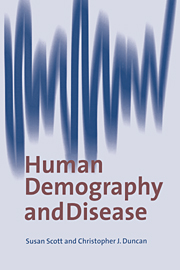Book contents
- Frontmatter
- Contents
- Preface
- Conversion table for imperial to metric units
- 1 Introduction
- 2 Tools for demography and epidemiology
- 3 Identification of population oscillations: a case study
- 4 Density-dependent control and feedback
- 5 Modelling the endogenous oscillations and predictions from timeseries analysis
- 6 Cycles in the grain price series
- 7 Interactions of exogenous cycles: a case study
- 8 Mortality crises and the effects of the price of wool
- 9 Modelling epidemics for the demographer: the dynamics of smallpox in London
- 10 Non-linear modelling of the 2-yearly epidemics of smallpox: the genesis of chaos?
- 11 Measles and whooping cough in London
- 12 Integration of the dynamics of infectious diseases with the demography of London
- 13 Smallpox in rural towns in England in the 17th and 18th centuries
- 14 Infectious diseases in England and Wales in the 19th century
- 15 Prospectives – towards a metapopulation study
- References
- Index
7 - Interactions of exogenous cycles: a case study
Published online by Cambridge University Press: 25 January 2010
- Frontmatter
- Contents
- Preface
- Conversion table for imperial to metric units
- 1 Introduction
- 2 Tools for demography and epidemiology
- 3 Identification of population oscillations: a case study
- 4 Density-dependent control and feedback
- 5 Modelling the endogenous oscillations and predictions from timeseries analysis
- 6 Cycles in the grain price series
- 7 Interactions of exogenous cycles: a case study
- 8 Mortality crises and the effects of the price of wool
- 9 Modelling epidemics for the demographer: the dynamics of smallpox in London
- 10 Non-linear modelling of the 2-yearly epidemics of smallpox: the genesis of chaos?
- 11 Measles and whooping cough in London
- 12 Integration of the dynamics of infectious diseases with the demography of London
- 13 Smallpox in rural towns in England in the 17th and 18th centuries
- 14 Infectious diseases in England and Wales in the 19th century
- 15 Prospectives – towards a metapopulation study
- References
- Index
Summary
Introduction
Human populations often appear to fluctuate in response to cyclic patterns in the economic or natural environment. Short-run variations in grain prices (described in Chapter 6) and real wage levels have been suggested to be responsible for the fluctuations in fertility in England during 1541–1871 (Galloway, 1988) and for mortality cycles in England, Sweden and France (Lee, 1981; Eckstein et al., 1985; Richards, 1983; Bengtsson & Ohlsson, 1984; Weir, 1984). A study of the annual fluctuations in deaths in London (1670–1830) has shown that the epidemic diseases of typhus, fevers and smallpox were strongly associated with price increases (Galloway, 1985), and mortality was also found to be significantly associated with cold winters in England and Sweden (Lee, 1981; Eckstein et al., 1985). Food supply could constitute a dominant density-dependent factor that controls population dynamics, but there are few reliable records on which to base a quantitative analysis of the effects of malnutrition in the past and this has necessitated the use of data such as stature as a proxy for nutrition (Floud, Wachter & Gregory, 1990; Fogel, 1994). Historians and historical demographers have suggested correlations between food intake, disease and the mechanisms that push or pull populations and affect their stability (Rotberg, 1983). Recent research indicates that, in many European nations before the middle of the 19th century, the national production of food was at such low levels that the poorer classes were bound to have been malnourished and this led to a high incidence of disease (Duncan et al., 1994a; Fogel, 1994).
- Type
- Chapter
- Information
- Human Demography and Disease , pp. 113 - 144Publisher: Cambridge University PressPrint publication year: 1998



